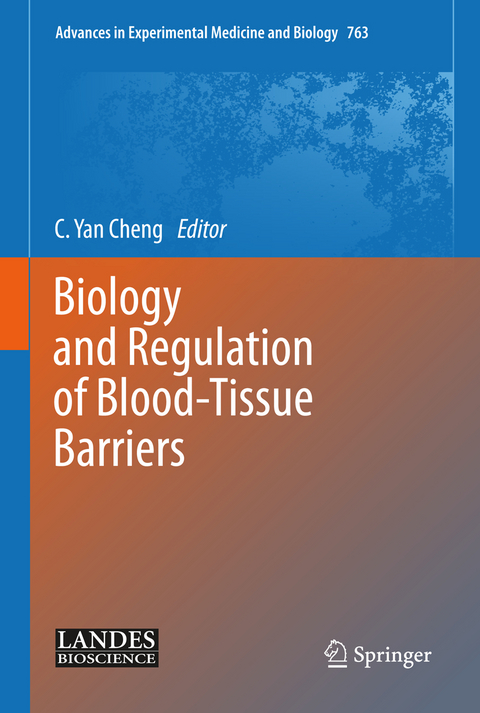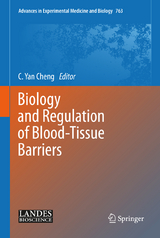Biology and Regulation of Blood‑Tissue Barriers
Springer-Verlag New York Inc.
978-1-4614-4710-8 (ISBN)
This book was written by many outstanding investigators who have spent decades to study different aspects of blood‑tissue barrier function. They have summarized some of the latest and fascinating development in their fields of research including the blood‑brain barrier, the blood‑retinal barrier, the gut barrier, the blood‑biliary barrier, the blood‑follicle barrier, the blood‑epididymis barrier, the blood‑testis barrier, the tight junction barrier in general as well as barriers in the female reproductive tract. Included are also chapters that focus on topics that are physiologically applicable to all blood‑tissue barriers. Many of these chapters also include information on specific human diseases, such as pathological changes of the gut barrier that cause bowel disorders resulting from inflammation of the epithelial lining in the intestine, and infertility in men as a result of disruption of the blood‑epididymal and/or blood‑testis barriers; and on new therapeutic approaches (e.g., drug delivery across the blood‑brain and the blood‑retinal barriers).
Dr. C. Yan Cheng is a native of Hong Kong and a graduate from the Chinese University of Hong Kong in 1977. Shortly after receiving his BSc, he began his graduate training in the laboratory of Professor Barry Boettcher at the University of Newcastle, New South Wales, Australia and received his PhD in 1981. He joined the laboratory of Dr. C. Wayne Bardin as a postdoctoral fellow, working with him and Drs. Neal A. Musto and Glen Gunsalus at the Population Council’s Center for Biomedical Research located on the campus of the Rockefeller University in New York City for a little over 4 years. During this period, he had the opportunity to interact with a number of eminent scientists and visiting scientists who were at the Population Council including Drs. Jennie Mather, Vilma Rossi, and Geoffrey Hammond. Dr. Bardin had also created an unprecedented stimulating and competitive environment that shaped his career in life sciences. Through his collaboration with Dr. Vilma Rossi, he met Professor Bruno Silvestrini in the summer of 1985 in New York, and began a scientific collaboration that spans more than two decades to develop new derivatives of indazole‑carboxylic acid for male contraception with the development of adjudin, 1‑(2,4‑dichlorobenzyl)‑1H‑indazole‑3‑carbohydrazide, as a potential male contraception. He has also used different animal models, such as the adjudin model, the cadmium model, the bisphenol A model and a few genetic models to study different aspects of testicular function in particular the biology and regulation of cell adhesion in the testis. Through this work, he and his colleagues, Drs. Helen Yan, Elissa Wong, Will Lee and Dolores Mruk, have discovered a functional axis that links the different cellular compartments in the seminiferous epithelium of the testis known as the apical ectoplasmic specialization‑blood‑testis barrier‑hemidesmosome/basement membrane axis that coordinates different cellular events during theseminiferous epithelial cycle of spermatogenesis. They have also identified several putative signaling pathways and nonreceptor protein kinases, such as focal adhesion kinase (FAK ) and members of the c‑Src kinases, that regulate blood‑testis barrier dynamics. Some of these findings are currently under development to design innovative compounds for male contraception. For the past three decades, his laboratory has received supports from the Angelini Research Institute, Rockefeller Foundation, Lupus Foundation of America, CONRAD Program, USAID, and the National Institutes of Health. He has published over 300 research articles and reviews in peer‑reviewed journals in the field. He is currently a Senior Scientist and the Head of the Mary M. Wohlford Laboratory for Male Contraceptive Research at the Population Council’s Center for Biomedical Research in New York City. 1H‑indazole‑3‑carbohydrazide, as a potential male contraception. He has also used different animal models, such as the adjudin model, the cadmium model, the bisphenol A model and a few genetic models to study different aspects of testicular function in particular the biology and regulation of cell adhesion in the testis. Through this work, he and his colleagues, Drs. Helen Yan, Elissa Wong, Will Lee and Dolores Mruk, have discovered a functional axis that links the different cellular compartments in the seminiferous epithelium of the testis known as the apical ectoplasmic specialization‑blood‑testis barrier‑hemidesmosome/basement membrane axis that coordinates different cellular events during the seminiferous epithelial cycle of spermatogenesis. They have also identified several putative signaling pathways and nonreceptor protein kinases, such as focal adhesion kinase (FAK ) and members of the c‑Src kinases, that regulate blood‑testis barrier dynamics. Some of these findings are currently under development to design innovative compounds for male contraception. For thepast three decades, his laboratory has received supports from the Angelini Research Institute, Rockefeller Foundation, Lupus Foundation of America, CONRAD Program, USAID, and the National Institutes of Health. He has published over 300 research articles and reviews in peer‑reviewed journals in the field. He is currently a Senior Scientist and the Head of the Mary M. Wohlford Laboratory for Male Contraceptive Research at the Population Council’s Center for Biomedical Research in New York City.
Regulation of Permeability Across the Blood‑Brain Barrier.- Drug Transporters at Brain Barriers: Expression and Regulation by Neurological Disorders.- The Blood‑Retina Barrier: Tight Junctions and Barrier Modulation.- The Inner Blood‑Retinal Barrier: Molecular Structure and Transport Biology.- Endothelial and Epithelial Barriers in Graft‑Versus‑Host Disease.- Structure and Regulation of Intestinal Epithelial Tight Junctions: Current Concepts and Unanswered Questions.- Polarity Protein Complex Scribble/Lgl/Dlg and Epithelial Cell Barriers.- The Blood‑Biliary Barrier, Tight Junctions and Human Liver Diseases.- The Blood‑Follicle Barrier (Bfb) in Disease and in Ovarian Function.- Physiology and Pathophysiology of the Epithelial Barrier of the Female Reproductive Tract: Role of Ion Channels.- The Blood‑Epididymis Barrier and Human Male Fertility.- Blood‑Tissue Barriers: Morphofunctional and Immunological Aspects of the Blood‑Testis and Blood‑Epididymal Barriers.- Gap Junctions and Blood‑Tissue Barriers.- Transcriptional Regulation of Cell Adhesion at the Blood‑Testis Barrier and Spermatogenesis in the Testis.- c‑Src and c‑Yes are Two Unlikely Partners of Spermatogenesis and Their Roles in Blood‑Testis Barrier Dynamics.- Role of P‑Glycoprotein at the Blood‑Testis Barrier on Adjudin Distribution in the Testis: a Revisit of Recent Data.- The Apical Ectoplasmic Specialization‑Blood‑Testis Barrier FunctionalAxis is a Novel Target for Male Contraception.
| Reihe/Serie | Advances in Experimental Medicine and Biology ; 763 |
|---|---|
| Zusatzinfo | XX, 361 p. |
| Verlagsort | New York, NY |
| Sprache | englisch |
| Maße | 178 x 254 mm |
| Themenwelt | Studium ► 1. Studienabschnitt (Vorklinik) ► Physiologie |
| Naturwissenschaften ► Biologie ► Genetik / Molekularbiologie | |
| ISBN-10 | 1-4614-4710-0 / 1461447100 |
| ISBN-13 | 978-1-4614-4710-8 / 9781461447108 |
| Zustand | Neuware |
| Haben Sie eine Frage zum Produkt? |
aus dem Bereich




